Navigating the Crypto Maze: A Deep Dive into Due Diligence
Let’s be honest. The crypto space can feel like the Wild West. One minute you’re reading about a 100x gain, the next you’re hearing about a catastrophic rug pull. It’s a world of incredible opportunity but also significant danger. The single most powerful tool you have to separate the gems from the junk is thorough due diligence. It’s the boring, unglamorous work that happens before you click ‘buy’, and it’s what can save you from devastating losses. This guide is your roadmap to understanding and mitigating the inherent crypto investment risks by teaching you how to properly investigate a project from the ground up.
Think of it like this: you wouldn’t buy a house without an inspection, right? You’d want to know about the foundation, the plumbing, the roof. So why would you throw your hard-earned money into a digital asset without doing the same level of inspection? Many people skip this step, driven by FOMO (Fear Of Missing Out) and hype. Don’t be one of them. Taking a few hours, or even days, to research can be the difference between a calculated investment and a reckless gamble. We’re going to break down the process into actionable steps that anyone can follow, regardless of your technical expertise.
Key Takeaways
- Due Diligence is Non-Negotiable: It is the most critical step to mitigate crypto investment risks and avoid scams.
- Look Beyond the Hype: A project’s value is found in its fundamentals—the team, technology, and tokenomics—not just its marketing.
- The Whitepaper is Your Starting Point: It outlines the project’s purpose, problem-solving approach, and technical details. If it’s vague or non-existent, that’s a massive red flag.
- Trust, But Verify: Investigate the development team’s background, track record, and transparency. Anonymous teams carry significantly higher risk.
- Tokenomics Tell the Story: Understanding token supply, distribution, and utility is crucial for assessing a project’s long-term economic viability.
The Core Pillars of Crypto Due Diligence
Effective due diligence isn’t a single action; it’s a comprehensive framework. It’s about asking the right questions and knowing where to find the answers. We’ll explore seven key pillars that, when combined, give you a 360-degree view of a crypto project. Let’s get started.
Step 1: Scrutinize the Whitepaper (The Project’s Bible)
The whitepaper is the foundational document of any legitimate crypto project. It’s a detailed report that should clearly explain what the project is, what problem it solves, how its technology works, and its plans for the future. If a project doesn’t have a whitepaper, or if it’s a poorly written, copy-pasted document full of buzzwords and empty promises, you should probably close the browser tab and walk away. Seriously.
When you’re reading it, you’re not just looking for technical jargon. You’re looking for clarity, coherence, and a real-world use case. Does the project actually need a blockchain to solve the problem it identifies? Or is it just using ‘blockchain’ as a marketing gimmick? Be a skeptic.
- Problem & Solution: Does it clearly define a real-world problem? Is the proposed blockchain-based solution genuinely better, faster, or cheaper than existing solutions?
- Technical Architecture: How does the technology work? You don’t need to be a developer, but it should explain the consensus mechanism (e.g., Proof-of-Work, Proof-of-Stake), the blockchain structure, and how it achieves its goals.
- Clarity and Professionalism: Is the document well-written, free of grammatical errors, and professionally formatted? A sloppy whitepaper often reflects a sloppy project.
- Plagiarism Check: It’s shockingly common for scam projects to plagiarize whitepapers from successful ones. Copy a few unique sentences and paste them into a search engine to check for duplicates.
Step 2: Investigate the Team (Who’s Behind the Curtain?)
An idea is only as good as the team executing it. You need to know who is building this project. A credible project will be proud to showcase its team. Look for a dedicated ‘Team’ or ‘About Us’ section on their website.
You want to see real names, real photos, and links to professional profiles like LinkedIn. An anonymous or pseudonymous team is a significant red flag. While the creator of Bitcoin, Satoshi Nakamoto, was anonymous, that was a unique, lightning-in-a-bottle event. For 99.9% of projects today, anonymity often hides a lack of experience or malicious intent. Once you have their names, your real detective work begins:
- LinkedIn Investigation: Check their profiles. Do their listed experiences match what the project claims? Do they have relevant experience in blockchain, software development, finance, or marketing?
- Track Record: Have they been involved in other successful projects (crypto or otherwise)? Conversely, have they been associated with failed projects or scams in the past? A quick web search of their name + ‘scam’ or ‘review’ can be very revealing.
- Advisors and Partners: Who is advising the project? Are they reputable figures in the industry? Are the claimed partnerships real? Don’t just take the website’s word for it. Check the partner company’s website or social media to see if they’ve announced the partnership too.
A transparent, experienced, and publicly accountable team is one of the strongest indicators of a project’s legitimacy. If you can’t find clear information about who is running the show, you’re taking on an enormous and unnecessary risk.

Step 3: Analyze the Tokenomics (The Economic Engine)
Tokenomics—a mashup of ‘token’ and ‘economics’—is the science of a cryptocurrency’s economic model. It’s arguably the most critical factor for determining a token’s potential long-term value. Bad tokenomics can doom even the most promising technology. Here’s what to look for:
- Total Supply and Circulating Supply: What is the maximum number of tokens that will ever be created (max supply)? How many are currently in circulation? A high max supply or an inflationary model (where new tokens are constantly created) can suppress the price. Look for deflationary mechanisms, like token burns, which can increase scarcity and value over time.
- Token Distribution: How were the initial tokens distributed? A fair launch is ideal, but many projects have a pre-mine. Look at the allocation. How much is reserved for the team and early investors? If a huge percentage (say, >30-40%) is held by insiders, they could dump their tokens on the market, crashing the price. Look for vesting schedules, where team/investor tokens are locked up and released gradually over months or years. This shows a long-term commitment.
- Utility (The ‘Why’): What is the token actually used for? Does it have a real purpose within the project’s ecosystem? Common utilities include paying for transaction fees, participating in governance (voting on the project’s future), or staking to earn rewards. A token with no clear utility is a purely speculative asset and much riskier.
Step 4: Audit the Technology and Security (Is it Bulletproof?)
In crypto, code is law. A single vulnerability in a project’s smart contract can lead to the loss of all funds. It has happened countless times. This makes security one of the paramount concerns when evaluating any project, especially in areas like DeFi (Decentralized Finance).
You need to verify that the project takes its security seriously. The gold standard for this is a professional third-party security audit. Reputable firms like CertiK, Quantstamp, or Trail of Bits are hired by projects to meticulously examine their code for vulnerabilities. Projects that have undergone an audit will proudly display the report on their website. Go and read it! The report will detail any issues found (from minor to critical) and whether the team has fixed them. No audit? That’s a huge risk. It could mean the team is either cutting corners to save money or, worse, they know their code is flawed and don’t want anyone to see it.
Step 5: Gauge Community and Social Sentiment (The Vibe Check)
A crypto project is nothing without its community. A strong, active, and engaged community is a powerful sign of a project’s health and potential for growth. But you need to learn how to distinguish between a genuine community and a manufactured one full of bots and paid shills.
Dive into their main social channels—typically Discord, Telegram, Twitter, and Reddit. Don’t just look at the number of followers or members. That’s a vanity metric that can be easily faked. Instead, look for the quality of the conversation.
- Engagement Quality: Are people asking intelligent questions about the technology and roadmap? Are the developers and moderators actively and transparently answering them? Or is the chat just filled with ‘wen moon?’ and rocket emojis?
- Red Flags: Be wary of excessive hype, promises of guaranteed returns, and the banning or deleting of critical questions. A healthy community welcomes skepticism and discussion. A cult-like atmosphere that shuts down any form of dissent is a major warning sign.
- Developer Communication: How do the founders and developers interact with the community? Are they present? Do they provide regular updates? Transparent communication builds trust, which is a priceless asset in this space.
Step 6: Check the Roadmap and Development Activity (Are They Building?)
A project’s roadmap is its statement of intent. It lays out the planned milestones, feature releases, and future goals. A good roadmap is ambitious but realistic, with clear, specific timelines. A vague roadmap with buzzwords like ‘Implement AI Synergy’ or ‘Revolutionize Metaverse’ without specifics is a red flag.
More importantly, you need to check if they are actually sticking to their roadmap. Are they hitting their deadlines? Have they delivered on past promises? Talk is cheap. The proof is in the code. This is where a tool like GitHub comes in. GitHub is a platform where developers store and manage their code. Most legitimate crypto projects have a public GitHub repository.
You don’t need to be a coder to get value from it. Look for the ‘commits’ or ‘contributions’ section. This shows how frequently the developers are working on the code. You want to see consistent, recent activity. If the last update was six months ago, the project might be abandoned. Consistent development activity is a strong signal that the team is actively working to build and improve their product.
Step 7: Understand the Market and Competitors (The Bigger Picture)
No project exists in a vacuum. You need to understand the specific niche it operates in and who its competitors are. Is it a Layer-1 blockchain, a DeFi lending protocol, a GameFi project, or something else?
Once you’ve identified its category, research the existing players. How does this new project compare? What is its unique value proposition? Is it offering a solution that is 10x better, faster, or cheaper than the established leaders? If it’s just a slightly different version of an existing, successful project, it may struggle to gain market share. A project that is creating an entirely new market or has a clear, defensible advantage over its competitors has a much higher chance of success. This analysis helps you understand the Total Addressable Market (TAM) and the project’s realistic potential for capturing a piece of it.

Conclusion
Performing due diligence to mitigate crypto investment risks isn’t a shortcut to guaranteed profits. Nothing is guaranteed in investing. What it is, however, is a robust process for filtering out the obvious scams, the weak projects, and the overhyped duds. It shifts the odds significantly in your favor.
It can feel like a lot of work, but with practice, you’ll develop a system and a keen eye for what matters. Start small. Pick a project you’re interested in and run it through these seven steps. The more you do it, the faster and more intuitive it will become. Remember, in a market as volatile and unpredictable as crypto, knowledge isn’t just power—it’s your shield. Invest with your brain, not your FOMO. Your future portfolio will thank you for it.


